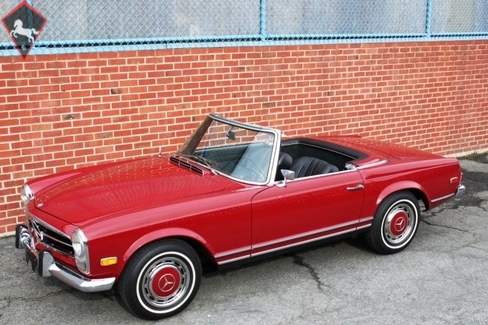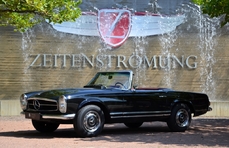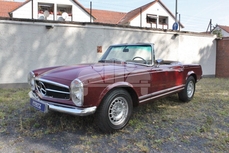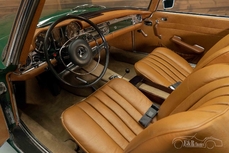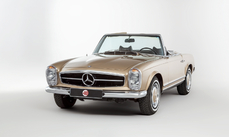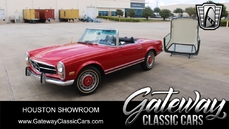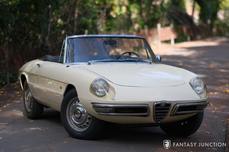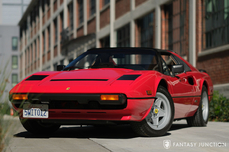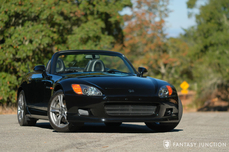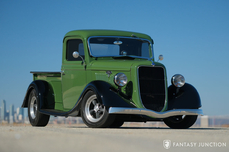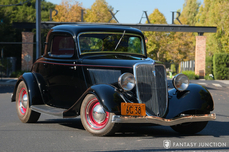Mercedes-Benz 280SL w113 2.8 Litre 6-Cylinder no. 130.983.10.001076 1968
General description :
1968 Mercedes-Benz 280SL 4-Speed
s/n 113.044-10-003936, engine no. 130.983.10.001076
Medium Red with Black Interior
Representing Mercedes-Benz's trend towards producing more usable and practical sports cars, the 230/250/280SL line was meant to replace both the 190SL and the illustrious 300SL. The car was a comfortable two-seater that was to be neither too big nor too expensive, and exhibited excellent roadholding thanks to the innovative and sophisticated rear suspension design. Built to Mercedes' usually high standards and employing excellent visibility, the cars were popular and sold well. The cars were continuously developed, with the 280SL being the ultimate version of the car, with its larger more powerful engine and all around disc brakes.
This particular car is a wonderfully unmolested example that has exceptional integrity. The car was originally finished in medium red with black interior and soft top, the color combination it wears today. The original options included the following:
401 single seats
416 hardtop mounted
461 instruments and mileage reading in English
491 US version
503 outside rear view mirror left
515 Becker AM/FM radio Europa
524 paint coat preservation
591 tinted windshield, darker on top
600 trim strips on hardtop
641 whitewall tires
669 spare wheel
835 coco mats
Sold new on 23 August 1968 to Stanley Schroeder, who was stationed at the Point Mugu Naval Air Station near Oxnard, California, the car was regularly serviced at Turnbull & Gamble in Oxnard, California until 1970, from which point on, it was serviced at either Smythe European in San Jose, California, or Hans Nissen in Santa Clara, California. Schroeder sold the car on 19 August 1972 to Steve Wilson of Soquel, California, who eventually registered the car to his business, Western Research Industries, Inc. of Capitola, California on 24 July 1978. He maintained the car regularly, and in 1984, the engine was replaced at Stahl Motors, the Mercedes-Benz dealer in Monterey, California. The original engine is included with the car. He retained the car until giving it to his niece in the early 1990s, who took it with her when she moved to Western Massachusetts in 1994. She drove the car sparingly, covering just 300 miles between 1994 and 2010, and the car was recommissioned in 2010.
In July of 2013, the car received a bare metal repaint in its original color of DB576 medium red, and was found to be extremely undisturbed, with original sheetmetal in place and in excellent condition. The car never received any undercoating and is in excellent undisturbed condition underneath as well.
The car is in excellent cosmetic condition. Aside from the paint and some of the weather stripping, the car is extremely original. The body is wonderfully straight and solid, retaining the headlight notches and factory spot welds. The fit and panel operation is exemplary throughout and the paintwork was done to high standards and remains excellent. The chrome appears to be original and is very nice considering this, but does have some light pitting. The glass appears to be original throughout and there are some chips in the windscreen. The top was recently replaced with correct Haartz canvas. The car retains its early 280SL features such as clear front indicator lenses, red rear lenses, and lack of headrests.
The interior is in excellent original condition. The MB Tex upholstery has never been renewed and has survived very well, with light wear only. The steering wheel is like new, and the car has period Kangol 3-point safety belts. The dashboard is excellent, both the upholstered and painted areas. The chrome trim, switches, instruments, and controls are also in excellent original condition, as are the door panels. The original Becker radio is in place and still works. The wood is in very good condition, with some aging but no major issues, while the carpets, also original, are showing some wear on the floor mat sections while the remaining carpets are in very good condition.
The engine compartment is tidy and correct throughout, but not detailed to show standards. There are plenty of signs of maintenance, and the original heat pad is present and has survived well, particularly given how they tend to deteriorate in these cars. The hood is stamped with the last four digits of the car’s body number, 3417. The trunk presents nicely as well, with correct rubber mat and spare tire cover. The paint is in excellent condition and the trunk floor is structurally and cosmetically excellent.
The car runs and drives well. It starts easily and the combination of the motor and the gearing provides impressively quick acceleration, a marked difference over an automatic example. The gearbox shifts well and the clutch is easy to modulate and smooth in its operation. The brakes are impressively effective for a car of any age, but particularly remarkable for a car from 1960s. The chassis and suspension provide sure-footed handling and the car is genuinely engaging to drive.
The car is extremely complete, with coco mats, service records back to the late 1970s, jack, lug wrench, tool roll, tools, and one of the most complete books sets we have ever encountered with a W113. It includes the following items:
Original books pouch
Owner’s manual
Stamped service book, 15 stamps from the late 1960s and early 1970s
Mercedes service directory for Africa, Asia, Australia, and America
Parts book
Genuine Mercedes detailing supplies brochure
Original build cards
Original Becker guarantee card
Becker dealer directory
Hirschmann antenna wipe
Bosch dealer directory
Original Mercedes full model line brochures, small and large
Technical data for passenger cars book
This is an exceptional opportunity to acquire a wonderfully undisturbed 280SL that was in the same family for nearly forty years. Structurally outstanding and fundamentally unrestored, the car is exceptionally honest and well-documented. Additionally, it is a comparatively rare manual transmission example, and drives extremely well and is highly complete. Consequently, this would be an extremely difficult car to duplicate, and will appeal to the sophisticated enthusiast or collector seeking a special 280SL that emphasizes originality.
http://fantasyjunction.com/cars/1630-Mercedes-Benz-280SL%20-2.8%20Litre%206-Cylinder
1968 Mercedes-Benz 280SL w113 2.8 Litre 6-Cylinder no. 130.983.10.001076 is listed sold on ClassicDigest in Emeryville by Fantasy Junction for $98500.
Car Facts
Car type : Car Make : Mercedes-Benz Model : 280SL w113 Model Version : 2.8 Litre 6-Cylinder no. 130.983.10.001076 Engine size : 2.8 Model Year : 1968 Sub type : Convertible Location : Emeryville Vehicle Registration : Normal
Sold
Seller Information
Sold
People who viewed this Mercedes-Benz 280SL w113 also viewed similar Mercedes-Benz listed at ClassicDigest
Other cars listed for sale by this dealer
About Mercedes-Benz
In the annals of automotive history, the journey of Mercedes-Benz is a tale that unfolds with the ingenuity of its founding pioneers. In the year 1886, Karl Benz crafted the Benz Patent Motorwagen, a creation that would go down in history as the world's inaugural automobile. Unbeknownst to him, this moment marked the genesis of what would evolve into the most illustrious premium car manufacturer globally. The financial underpinning of this pioneering venture, interestingly, was provided by Karl Benz's wife, Bertha Benz, demonstrating a remarkable partnership that would set the tone for Mercedes-Benz's legacy.A parallel narrative emerged not far away, as Daimler-Motoren-Gesellschaft, founded by Gottlieb Daimler and Wilhelm Maybach, entered the scene. In 1901, they unveiled their automobile under the now-famous moniker "Mercedes," meaning "godsend" in Spanish. This name was bestowed upon the car at the behest of Emil Jellinek's daughter, the distributor for Daimler-Motoren-Gesellschaft. The wheels of innovation were set in motion.
Fast forward to 1926, a pivotal year that witnessed the merger of Daimler with Benz & Cie., culminating in the birth of Daimler-Benz. The amalgamation saw the adoption of "Mercedes-Benz" as the distinguished trademark for their automobiles, fusing the legacies of two visionary entities into one.
Contrary to perceptions of conservatism, the trajectory of Daimler-Benz unfolds as a chronicle of industry firsts. From the introduction of the honeycomb radiator to the float carburetor, and the pioneering implementation of four-wheel brakes in 1924, Daimler-Benz consistently pushed the boundaries of automotive innovation. The diesel-powered Mercedes-Benz 260 D in 1936 marked the inception of diesel engines in passenger cars. The iconic Mercedes-Benz 300SL Gullwing made history as the first car with direct fuel injection, albeit the Gutbrod's tiny 2-stroke engine can claim precedence.
Safety innovations became a hallmark, with Béla Barényi's patented safety cell design in the "Ponton"-models in 1951, featuring front and rear crumple zones. The W116 450SEL 6.9 saw the introduction of the Anti-Lock Brake system (ABS), another pioneering safety feature. From the first production airbags and beyond, the legacy of "firsts" continued to be etched into the fabric of Daimler-Benz.
Over its centennial journey, Mercedes-Benz has not merely produced cars but has sculpted automotive icons. The SSKL, 710 SSK Trossi Roadster, 770K Grosser, 540K Spezial Roadster, 300SL Gullwing, w100 600 Pullman, w111 280SE 3.5 Flachkühler, w113 230SL Pagoda, w109 300 SEL 6.3, and w201 2.3-16 Cosworth stand testament to the brand's commitment to engineering excellence.
The roaring Silver Arrows, or "Silberpfeile," including the W 25, W 125, W154, W165, and W196, created a legacy of dominance on the racetrack. These machines were not merely cars; they were expressions of precision, speed, and an indomitable spirit that left their competitors in the dust.
As Mercedes-Benz marches into the future, it does so not just as an automaker but as a custodian of a legacy, a torchbearer of innovation, and a beacon of automotive excellence. The road ahead is sure to witness the continued fusion of cutting-edge technology, timeless design, and an unwavering commitment to setting new standards in the world of automobiles.
One luminary figure who left an indelible mark was Béla Barényi, often heralded as the "father of passive safety" for his pioneering work in safety engineering. His patented safety cell design, featuring front and rear crumple zones, became a hallmark of Mercedes-Benz's commitment to occupant safety, setting new standards that reverberated throughout the automotive world.
Moving through the chronicles, the collaborative genius of Wilhelm Maybach, alongside Gottlieb Daimler, laid the foundation for Daimler-Motoren-Gesellschaft. Their innovations not only birthed the first Mercedes but established a culture of relentless pursuit of technological excellence that remains integral to Mercedes-Benz's DNA.
In the post-merger era of 1926, Ferdinand Porsche emerged as a prominent figure within Mercedes-Benz. His work on the Mercedes-Benz S-Type, a supercharged race car, garnered acclaim and set the stage for a legacy that extended far beyond the marque. Porsche's impact would later extend to his eponymous company, but his influence at Mercedes-Benz during those formative years was pivotal.
As the 20th century progressed, the legendary Rudolf Uhlenhaut emerged as a key figure. Uhlenhaut, an accomplished engineer and the driving force behind the iconic Silver Arrows, played a crucial role in Mercedes-Benz's dominance in motorsports. His engineering prowess and attention to detail were instrumental in creating some of the most formidable racing cars of the era.
In the latter half of the century, figures like Bruno Sacco, the head of design at Mercedes-Benz from 1975 to 1999, left an indelible imprint on the brand's aesthetic identity. Sacco's design philosophy, characterized by clean lines and timeless elegance, shaped iconic models like the W126 S-Class and the W201 190E, solidifying Mercedes-Benz's reputation for luxury and sophistication.
The narrative would be incomplete without acknowledging the contributions of engineers like Hans Scherenberg, whose leadership in the 1970s ushered in a new era of technological innovation at Mercedes-Benz. Scherenberg's tenure saw the development of groundbreaking technologies, including the Anti-Lock Brake system (ABS) and the introduction of airbags in production cars.
